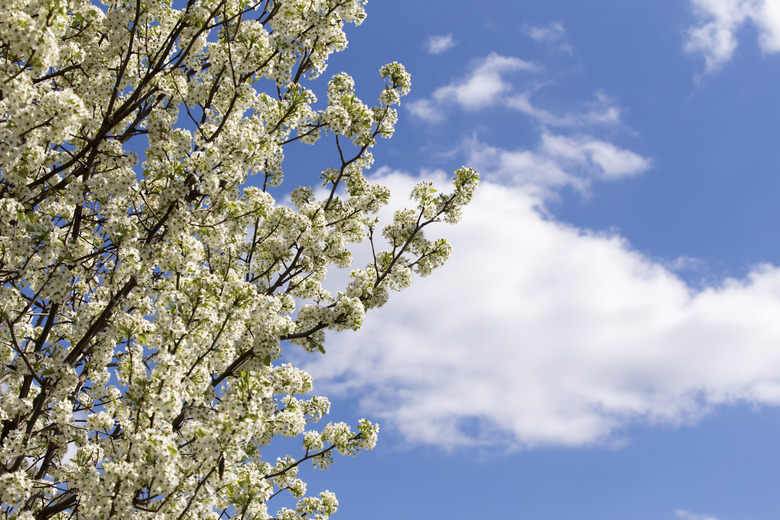Fire Blight Treatment For Pear Trees
Black or brown leaves that don't fall are characteristic of fire blight, and this scorched look gives the disease its name. Infecting both edible pear trees (Pyrus communis), which are hardy in U.S. Department of Agriculture plant hardiness zones 4 through 9, and ornamental pears, such as Bradford (Pyrus calleryana "Bradford"), which grows in USDA zones 5 through 9, fire blight also causes wet, brown blossoms and hooked branch ends. Treatment involves pruning and spraying infected trees.
Cut It Out
Pruning and cutting out infected tissue controls fire blight (caused by the bacteria Erwinia amylovora) in pear trees. To avoid spreading the infection, sterilize pruning shears before each cut by dipping the blades in a solution of 1 part household bleach, 9 parts water and two or three drops of detergent. Prune pear trees in late winter, removing affected twigs and branches 8 to 12 inches below the diseased area. Cut out cankers in trunks and large branches with a sharp, sterilized knife. Cut into healthy tissue, and allow the bark to heal naturally. Tree wound paints are ineffective. Place all diseased pear tree debris in a sealed plastic bag in the trash.
- Black or brown leaves that don't fall are characteristic of fire blight, and this scorched look gives the disease its name.
- Prune pear trees in late winter, removing affected twigs and branches 8 to 12 inches below the diseased area.
Spray to Protect
Copper sprays, such as Bordeaux mixture, protect against fire blight on pear happens-trees-spring.html'>trees in spring. Put on safety goggles and protective clothing before applying Bordeaux mixture or any other pesticide. Dilute products containing 13.3 percent copper at a rate of 4 tablespoons per gallon of water, or according to the manufacturer's instructions. Put Bordeaux mixture powder in half the required water, shake the spray tank until all the powder has dissolved, and add the rest of the water. Start spraying as blossoms open and continue every five to seven days until they fade. Spraying Bordeaux mixture as fruits develop can cause scarring.
Apply Bactericides
Fire blight is a bacterial disease, and a few bactericides are available to home gardeners to treat pear trees. Resistance to bactericides is a problem in commercial pear production, and they should not be used after symptoms develop. Dilute a product containing 21.2 percent streptomycin sulfate at a rate of 1 tablespoon per 2 1/2 gallons of water, and spray pear trees every three to four days from the beginning to the end of blooming. Spray again every five to seven days during wet weather when the temperature is 70 to 81 degrees Fahrenheit, provided no fruit is visible, or dilute and apply the product according to the manufacturer's instructions.
- Copper sprays, such as Bordeaux mixture, protect against fire blight on pear trees in spring.
- Resistance to bactericides is a problem in commercial pear production, and they should not be used after symptoms develop.
Grow Resistant Cultivars
Pear trees that are resistant to fire blight offer the best long-term protection. Stark Ultra Red (Pyrus communis "Stark Ultra Red") is hardy in USDA zones 5 through 7b and bears creamy white early spring blossoms followed by deep red late summer fruit. Starking Delicious (Pyrus communis "Starking Delicious"), which grows in USDA zones 5 through 8, bears large golden late summer fruit. Grafted onto dwarf rootstock both trees grow 8 to 10 feet tall and wide, and 15 to 20 feet tall and wide when growing on standard rootstock.
References
- University of California IPM Online: Fire Blight
- Purdue University: Fire Blight on Fruit trees in the Home orchard
- The Ohio State University Extension: Fire Blight of Apples and Pears
- Missouri Botanical Garden: Pyrus Communis
- Missouri Botanical Garden: Pyrus "Stark Ultra Red"
- Missouri Botanical Garden: Pyrus "Starking Delicious"
- Missouri Botanical Garden: Pyrus Calleryana "Bradford"
